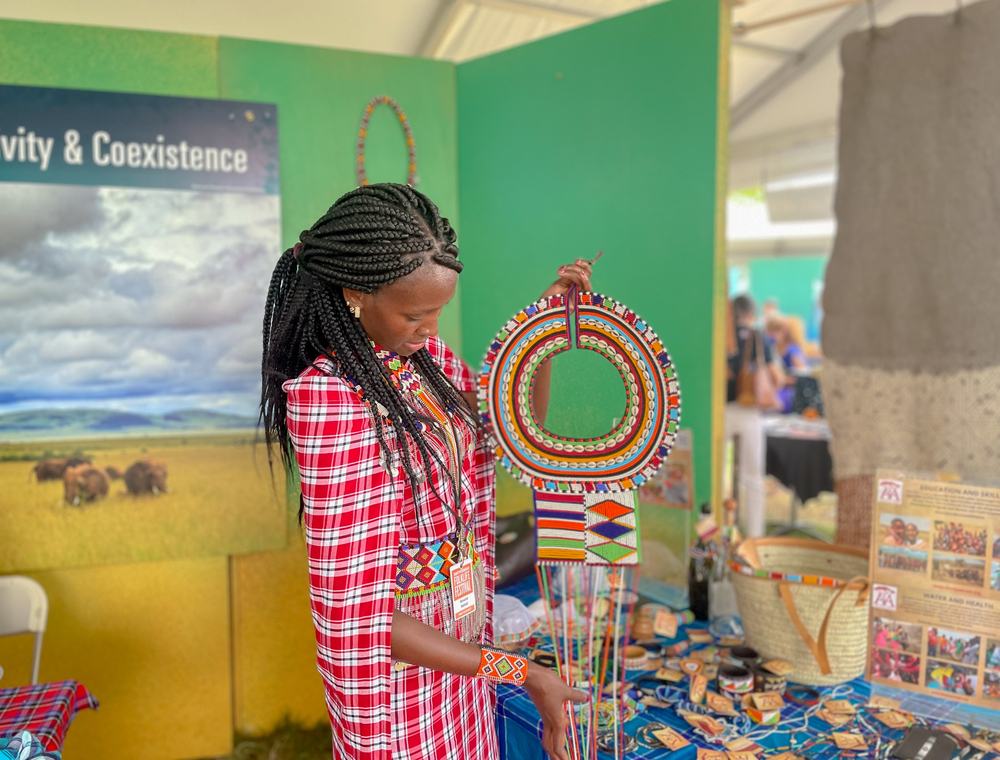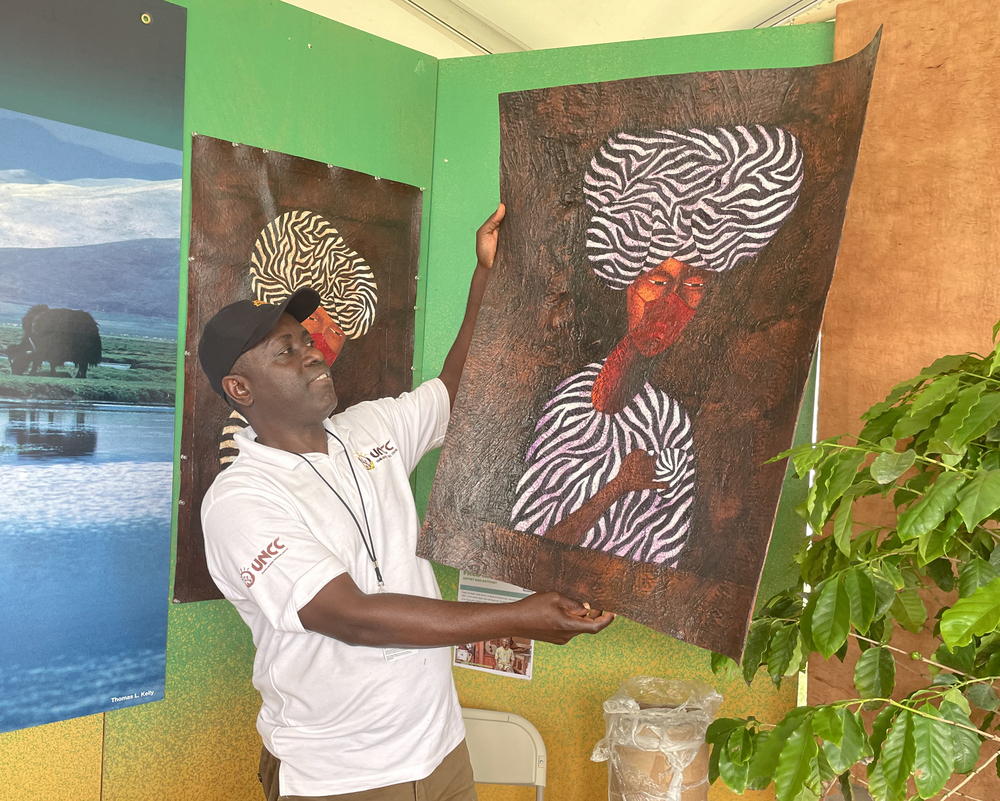
Since this blog began in 2014, we have covered the Smithsonian Folklife Festival. It's a two-week event in Washington, D.C., that brings artists and artisans from around the world to share their crafts, their songs, their food.
We've interviewed an Armenian calligrapher and a leather craftsman from Niger and attended a Peruvian alpaca blessing. We even sampled goat stew courtesy of a Kenyan chef with a restaurant in Washington, D.C.
Then came the pandemic. The festival was off for a couple of years but this year returned – and so did we.
From our global perspective, we were most interested in talking to crafters from the Global South – countries that may lack the resources of Western nations but that are incredibly resourceful when it comes to creating objects of beauty from the most ordinary elements. That would be: yak hair, tree bark and simple beads.
Why it's hard to pick up Maasai beading — literally

In one tent, there's an intricate necklace so large that it covers the shoulders and chest — and it's not just decorative. It's a gift for engaged women. Family and friends tie knots into the strands at the bottom of the necklace, which serve as a kind of ledger. The knots indicate how much livestock, for example, they will be giving to the couple as a gift for the wedding.
The colors are bold and symbolic, says Simaloi Saitoti, a Maasai woman who leads beadwork projects for Maa Trust, a nonprofit group in Kenya that conserves the culture of the nomadic Maasai as well as wildlife. "The green stands for the land. When it rains, the land gets green, so we are happy as pastoralists because we keep cows. White stands for peace, blue stands for energy, black stands for people and red is a symbol of the food that we eat."
Mainly women make the beaded jewelry and baskets that have been part of Maasai culture for hundreds of years, Saitoti explains. "Beading is something you learn from your parents, passed down through generations," says Saitoti. "It defines who I am as a Maasai."
Saitoti says Maa Trust helps Maasai women make money by selling their beaded jewelry on their behalf. The group, she adds, supports nearly 500 women through this program, which also teaches them how to save and spend money wisely.
At the festival, visitors try their hand at making their own jewelry, but it's not easy work. Thousands of beads are spread out across a table. They're too small to pick up with your fingers; the Maasai beaders show how to pick them up one by one on a stiff piece of wire, then thread the beads onto a fishing line that will service as a bracelet. It's an exercise in patience – and one that makes the dozens of elaborate pieces on display all the more impressive.
Horses and sheep give up their hair to make traditional Mongolian felt

In another tent, a large, abstract tapestry in tones of gray, cream, brown and black hangs from the ceiling. It's made out of fibers from different animals from Mongolia, including sheep, horse, camel and yak.
This fiber art was created by Mongolian artists Enkhbold Togmidshiirev and his wife, Munguntsetseg Lkhagvasuren. The tapestry was the couple's first collaborative piece of art. "It's special because we used natural materials [from the land] related to the Mongolian nomadic way of life," says Lkhagvasuren.
For thousands of years, Mongolian nomads have turned the hair and wool from animals into felt. The fabric is sewn into clothing for winter and is used to craft yurts for housing – practices that continue to this day.
At a table near their tent, the couple shows a festival visitor how to make felt. First, you must clean the animal hairs using hot water, then pound it with small stones to separate the fibers. Soak the fibers in water again to bind them together. Then tangle them up, roll that tangle out and press it by hand to make a fabric, which is left to air dry.
Felt is an important material in the couple's own work. Togmidshiirev often uses organic materials such as felt, ash, leather and wood in his contemporary art and performance pieces. And Lkhagvasuren, a fashion designer, makes clothing and boots from felt.
The couple hopes that by continuing to make art with felt people will appreciate the ancient practice. "We believe we can preserve this cultural tradition for many more years," says Togmidshiirev.
Painting on fabric made out of tree bark

Fred Mutebi proudly holds up a painting he made of a Ugandan woman wearing a zebra-printed headpiece and a matching dress at his tent at the festival.
What's remarkable about this portrait, he says, is that he made it on barkcloth, a canvas-like fabric that traces back to the Baganda Kingdom in southern Uganda 800 years ago. Mutebi uses barkcloth in his art as a way to keep the tradition alive.
For centuries, Ugandans used barkcloth to make clothing, bedding and even curtains and mosquito nets. At the festival, Aloyzius Luwemba, a 10th-generation barkcloth maker, demonstrates how the fabric is made. First, artisans harvest bark from the Mutuba tree, a species of ficus. They boil it until soft, then beat the bark into a fabric using special wooden mallets so that it stretches and expands. Although it's made from tree bark, the fabric is surprisingly soft and flexible enough to be pieced together into dresses and tunics — and a good canvas for painting as well.
Barkcloth is such a crucial part of Ugandan culture that in 2008, UNESCO declared it a "Masterpiece of Oral and Intangible Cultural Heritage." The title encourages communities to protect and sustain works of significant cultural expression. It joins Congolese rumba, falconry, Inuit drum dancing and singing, among hundreds of other traditions.

But Mutebi, a former Fulbright scholar who has exhibited his paintings and woodcut prints in galleries across Europe, the U.S. and Africa — says the traditional Ugandan craft is dying out. When Arab traders introduced cotton to the country in the 19th century, it widely replaced barkcloth as a material used for clothing and other goods. Today, artisans continue to make barkcloth, but it's often reserved for traditional costumes worn for special events like healing ceremonies or coronations for Ugandan tribal leaders.
Mutebi wants Ugandans to do more to preserve the craft of barkcloth. "I'm trying to mobilize a group of artists to collaborate with businessmen and politicians," to create a sustainable industry for barkcloth makers, he says. In the meantime, he will continue to use barkcloth as his canvas of choice for his art.







